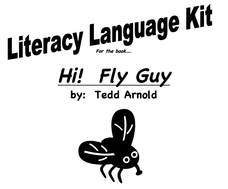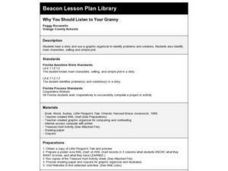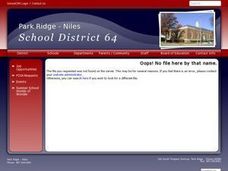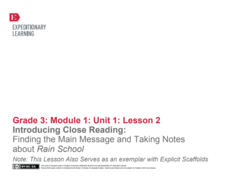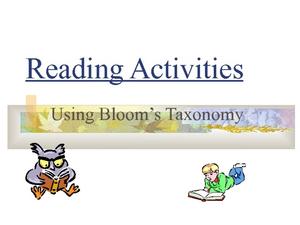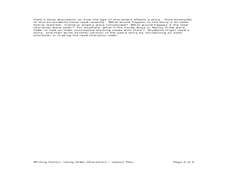Poston Butte High School
Literacy Language Kit for the Book Hi! Fly Guy
Create a buzz in your class with this collection of learning activities for the book Hi! Fly Guy. Including a list of comprehension questions, a sequence of events activity, a summary writing assignment, and a vocabulary list, this...
Curriculum Corner
Summary Writing
Nineteen stylish worksheets offer lesson ideas and practice opportunities designed to reinforce summary skills. Scholars recall events over the weekend as well as favorite books—main characters, problems, solutions, the beginning,...
EngageNY
Close Reading of Thank You, Mr. Falker: Identifying the Superpowers of Reading
Third graders read excepts from the story, Thank You, Mr. Falker in order to gain practice in understanding an unfamiliar story by focusing on the details. They use a worksheet, embedded in the plan, which directs them to certain...
EngageNY
Close Reading of That Book Woman: How Did People Access Books in Rural Areas of the United States?
For this ninth lesson plan in a larger beginning-of-the-year unit, close reading skills are used independently to find the gist of the story That Book Woman. Rereading for important details is the targeted skill to unlock a deeper...
Curated OER
Story Pyramid- Reading and Understanding a Story
Emerging readers follow eight steps to assist in their reading and understanding a story line. They name and describe the main character, setting, problem, events, and the story's ending using the specified number of words described in...
Curated OER
WHY YOU SHOULD LISTEN TO YOUR GRANNY
Learners hear a story and use a graphic organizer to identify problems and solutions. They also identify main characters, setting and simple plot. They illustrate one situation when they should listen to their parents.
Curriculum Corner
Fiction Graphic Organizers
Get an in-depth look into a narrative text with a three-page worksheet that examines a story's character—actions, sayings, thoughts, and appearance—setting, and challenges scholars to write a brief summary about what they've read.
Curated OER
Comprehension: Identify Story Grammar
This fully scripted lesson could be a big help for someone new to teaching Kindergarten. It outlines what you should do and say as you teach grammar and literary elements such as, main character, setting, and events through reading. The...
Curated OER
Out of the Dust: Background notes about the novel, The Great Depression, and The Dust Bowl
If your class is reading the historical fiction novel, Out of the Dust, then you are in luck. Here are a few slides that will help you provide historical context for the book, as well as define main characters, setting, symbolism, and...
Teacher's Corner
Compare and Contrast Dr. Seuss
Celebrate Read Across America Day and Dr. Seuss' birthday with this compare and contrast graphic organizer in which three stories are examined for their setting, characters, problems, events, and solution.
K5 Learning
Race Cars
Do you ever get nervous before a big event? A pair of race cars discuss their nerves before tomorrow's race in a reading activity that includes five comprehension questions.
EngageNY
Getting the Gist and Determining Word Meaning: Paragraphs 20–23 of Steve Jobs’ Commencement Address (and connecting to Chapter 10)
Groups create a list of the character traits of Steve Jobs and Buddy, the main character of Christopher Paul Curtis' Bud, Not Buddy, and share and select evidence from Jobs' 2005 Stanford University Commencement Address to support their...
Curated OER
An Author Study on Kevin Henkes
To better understand how the author Kevin Henkes uses the theme of friendship throughout his books, learners engage in several compare and contrast activities. The class reads several Henkes titles and discusses the similarities in...
Curated OER
Lesson Plan 7: The Elements of Story
Budding novelists work on character development by relating to the characters in their stories. They imagine their own hopes and dreams and recall those of characters from books they've read. Learners also consider struggles the...
EngageNY
Introducing Close Reading: Finding the Main Message and Taking Notes About Rain School
This second lesson in a larger unit is perfect for the beginning of the year because it explicitly teaches 3rd graders how to use close reading skills by identifying unfamiliar words, figuring out the gist, and defining important...
University of Virginia
Uncle Tom's Cabin: Reading the Novel
Teach the importance of context and perspective with a unit focused on Harriet Beecher Stowe's Uncle Tom's Cabin. The first lesson considers the role of female characters and readers, including the gender expectations of the time. The...
Curated OER
Charlotte's Web
In this literature activity, students, after reading Charlotte's Web, fill in the blanks inside of a pig that spell out five of the main characters from the novel and then color the pig.
Curated OER
Reading Comprehension
For this reading comprehension worksheet, 5th graders complete 3 long answer questions. Students must explain the setting and main characters of a story they read and give a paragraph summary.
Curated OER
Reading Activities Using Bloom's Taxonomy
This short, yet effective, presentation gives pupils many great tips on increasing their enjoyment of what they read and improving their comprehension. The categories of tips include analyzing, remembering, understanding, applying,...
EngageNY
Getting to Know Esperanza (Chapter 2: “Las Uvas/Grapes”)
Delve into Esperanza Rising by Pam Muñoz Ryan with close reading and evidence-based, text-dependent questions. Part of a unit series, this well-sequenced, Common Core designed instructional activity draws on material from the previous...
Mr. Mansour
Ralph S. Mouse by Beverly Cleary
Take an in-depth look into Beverly Cleary's story, Ralph S. Mouse, with a 10-question learning exercise that focuses on story elements. Scholars describe the main character, point of view, conflict resolution, and more! Then, conclude...
Curated OER
Bud, Not Buddy: Directed Reading Thinking Activity
Here’s a reading strategy that can be used with any text. Class members examine portions of a novel, and make predictions about the theme or subject matter of the book. Although designed for Christopher Paul Curtis’s Newbery Medal...
Curated OER
Writing Fiction: Using Older Characters
Out with the old and in with the new? Not so in this lesson plan, which explores the idea of writing older characters in fiction. Students learn the value of varying their characters, exploring different perspectives, and avoiding...
Curated OER
Using Wordless Comics To Help Create Meaning in Reading
Use picture cues as a tool in order to create meaning along with text. With a wordless comic, young illustrators discuss the main idea and character traits, and independently write a summary for a page of a wordless comic. This strategy...


